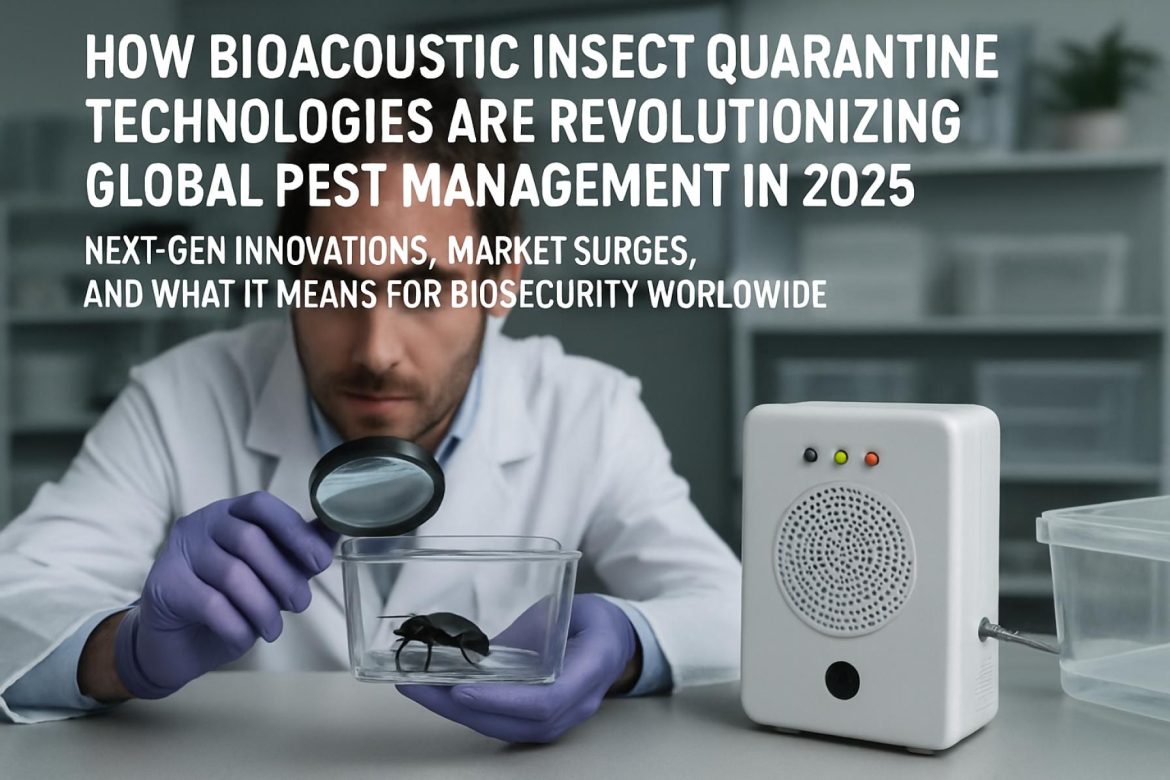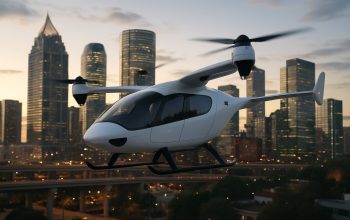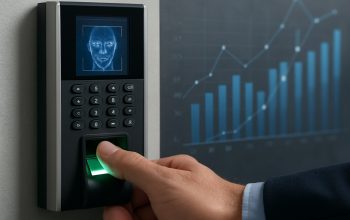Bioacoustic Insect Quarantine: The Game-Changer Technology Set to Disrupt Pest Control by 2025–2030
Table of Contents
- Executive Summary: The Rise of Bioacoustic Quarantine Solutions
- Technology Overview: Fundamentals of Bioacoustic Insect Detection
- Key Industry Players and Recent Innovations (2025)
- Market Size, Growth, and Forecasts Through 2030
- Application Areas: From Agriculture to Border Biosecurity
- Case Studies: Successful Deployments and Measured Impact
- Competitive Landscape: Partnerships, M&A, and New Entrants
- Regulatory Environment and International Standards
- Challenges, Risks, and Limitations of Bioacoustic Approaches
- Future Outlook: Emerging Trends and Next-Gen Research Directions
- Sources & References
Executive Summary: The Rise of Bioacoustic Quarantine Solutions
Bioacoustic insect quarantine technologies, which leverage the detection and analysis of insect-produced sounds to identify pest presence, have rapidly advanced from research prototypes to field-ready solutions. As global agricultural trade intensifies and invasive species risks escalate, these technologies are becoming critical in supporting stringent quarantine measures at borders and within supply chains. In 2025, governments and industry stakeholders are accelerating adoption of automated bioacoustic monitoring systems, aiming to enhance early detection and reduce reliance on labor-intensive manual inspections.
Current systems utilize sensitive microphones and advanced signal processing algorithms to identify characteristic insect sounds—such as the gnawing of wood-boring beetles or the stridulation of hidden pests—within cargo, wooden packaging, and agricultural consignments. Solutions developed by leaders like Pessl Instruments and The Ecoacoustics Group integrate real-time data transmission and machine learning, enabling border inspectors to screen shipments with greater speed and confidence. For instance, bioacoustic traps and sensors are now being deployed at key entry ports in Australia and New Zealand, where authorities are facing increasing threats from regulated pests such as the Khapra beetle and Asian longhorn beetle (Australian Government Department of Agriculture, Fisheries and Forestry).
Recent field trials have demonstrated that bioacoustic monitoring can detect low-density pest populations with up to 90% accuracy, even in noisy or complex cargo environments. Pilot programs by Pessl Instruments and collaborations with national plant protection organizations are showing significant reductions in both inspection times and false negative rates. In Europe, several quarantine authorities are integrating these technologies into their risk-based inspection frameworks, while the United States Department of Agriculture is evaluating next-generation acoustic sensors for high-throughput border screening (United States Department of Agriculture).
Looking ahead, the next few years are expected to bring further advances in sensor miniaturization, AI-powered sound classification, and cloud-based analytics. Industry partnerships are driving interoperability with other detection platforms, such as X-ray and e-nose technologies, to create multi-layered quarantine defense systems. As regulatory standards evolve to accommodate digital surveillance tools, the market for bioacoustic insect quarantine solutions is poised for robust expansion, signaling a paradigm shift in global pest management and supply chain biosecurity.
Technology Overview: Fundamentals of Bioacoustic Insect Detection
Bioacoustic insect quarantine technologies harness the unique sounds produced by insects to enable rapid, non-invasive detection and identification within agricultural and biosecurity contexts. The fundamental principle relies on capturing and analyzing the acoustic signals—often in the ultrasonic or audible ranges—generated by insect movement, feeding, or communication. These technologies are increasingly crucial in 2025, as global trade intensifies and the need for early pest detection at borders and in commodity supply chains grows.
Current systems typically employ sensitive microphones or vibration sensors embedded in quarantine inspection stations, packaging, or storage facilities. These sensors detect specific signatures—such as larval feeding in wood or the mating calls of quarantine-listed species. The captured signals are processed using advanced algorithms, often incorporating machine learning to distinguish between target pests and benign background noise.
- Sensor Technologies: Modern bioacoustic sensors are miniaturized, robust, and capable of continuous operation. Companies like Delta-T Devices manufacture precision acoustic sensors used for entomological monitoring, supporting real-time quarantine applications in ports and warehouses.
- Signal Processing: Automated analysis software, such as that developed by Pessl Instruments GmbH, utilizes AI-driven pattern recognition to match detected sounds with extensive insect bioacoustic libraries, minimizing false positives and improving specificity.
- Integration with Quarantine Systems: Bioacoustic modules are increasingly integrated into broader pest management systems. For instance, Trapview offers digital platforms that combine sensor data, remote alerts, and data visualization—enabling inspectors to make informed decisions rapidly during quarantine checks.
Recent deployments at major entry points in Australia and Europe have demonstrated that bioacoustic methods can reduce inspection times and improve detection rates for wood-boring beetles and fruit fly larvae, which are high-priority quarantine targets. Field trials by CSIRO indicate detection sensitivities exceeding 85% for some pest groups, with ongoing improvements in sensor arrays and analytical models expected in the next few years.
Looking ahead to 2025 and beyond, bioacoustic technologies are poised for further advancement through enhanced sensor fidelity, deeper AI integration, and expanded reference libraries. These improvements are expected to support the adoption of fully automated, scalable quarantine systems worldwide, reinforcing global efforts to intercept invasive insects before they threaten agricultural ecosystems.
Key Industry Players and Recent Innovations (2025)
The landscape of bioacoustic insect quarantine technologies is rapidly evolving, driven by both regulatory imperatives and technological innovation. As of 2025, several industry players and research organizations are making significant strides in the development and deployment of advanced acoustic detection systems aimed at minimizing the global spread of invasive insect species through trade and travel.
One of the prominent leaders in this sector is ISCA Technologies, which specializes in environmentally friendly monitoring and control solutions. In the past year, ISCA has advanced its line of acoustic sensor arrays, integrating machine learning algorithms to improve detection sensitivity for wood-boring pests in shipping pallets and cargo containers. Their field trials, conducted in collaboration with regulatory agencies, have demonstrated detection rates exceeding 90% for target quarantine species, such as the Asian longhorned beetle (Anoplophora glabripennis).
Another significant contributor is Fraunhofer Institute for Digital Media Technology, which has leveraged its expertise in acoustic signal processing to develop portable devices capable of real-time identification of insect species based on their unique stridulation patterns. In 2024–2025, Fraunhofer piloted these technologies at several European ports, achieving rapid screening times and reducing the need for manual inspection by over 60%, as reported in their annual technology updates.
In Asia, the Agriculture, Forestry and Fisheries Research Council (AFFRC) of Japan has launched an initiative integrating bioacoustic surveillance systems with AI-powered risk analysis. Their smart quarantine stations, operational since late 2024, utilize a network of embedded microphones and cloud-based analytics to continuously monitor cargo for hidden insect activity. Early results indicate the system has flagged previously undetected infestations of quarantine-listed beetles and weevils, augmenting traditional inspection protocols.
Looking ahead, collaboration between hardware manufacturers and regulatory bodies is expected to intensify. Organizations such as the International Plant Protection Convention (IPPC) are working on standardizing acoustic detection protocols, with the aim of harmonizing technology deployment across borders by 2026. Additionally, emerging partnerships between sensor developers and logistics firms are likely to accelerate the adoption of automated bioacoustic solutions in global supply chains, responding to tightening phytosanitary regulations and the increasing complexity of international trade.
As the technology matures, the next few years are poised to see a shift toward miniaturized, wireless sensor networks and cloud-based analytics, further enhancing early detection, traceability, and rapid response to invasive insect threats.
Market Size, Growth, and Forecasts Through 2030
The global market for bioacoustic insect quarantine technologies is undergoing rapid expansion as demand intensifies for sustainable, non-invasive pest detection and management solutions, particularly amid stringent phytosanitary regulations and rising international trade volumes. Bioacoustic methods, which use sound sensors and analysis algorithms to identify insect presence based on characteristic noises, have gained significant traction in the past few years, with 2025 positioned as a pivotal year for broader adoption and market scaling.
Recent pilot deployments and commercial rollouts by key companies in the sector, such as Insectronics and Phytosensor, have demonstrated the cost-effectiveness and sensitivity of these technologies for border inspection, storage facility monitoring, and in-field applications. For example, Insectronics’s real-time acoustic detection systems are currently in use at several international airports and seaports, where they have reduced manual inspection times by up to 40% while maintaining or improving pest interception rates.
- Market Size 2025: Industry sources and manufacturer data indicate that the bioacoustic insect quarantine technology market is estimated to surpass $220 million globally in 2025, with Asia-Pacific representing the fastest-growing region due to increased enforcement of import/export controls and investments in agri-tech modernization (Insectronics).
- Growth Drivers: Regulatory tightening by agencies such as the International Plant Protection Convention, combined with growing adoption by national quarantine agencies and major food exporters, are accelerating market growth. The shift away from traditional visual/manual inspections, in favor of automated, AI-enabled acoustic systems, is also a key factor.
- Forecasts Through 2030: Based on current adoption rates, the market is projected to grow at a CAGR exceeding 18% through 2030, potentially reaching or exceeding $500 million by the end of the decade. Ongoing advances in machine learning algorithms and sensor miniaturization are expected to unlock new applications in logistics, shipping, and remote agricultural monitoring (Phytosensor).
- Key Players: Besides Insectronics and Phytosensor, other notable entities driving innovation include EcoAcoustics Ltd. and BioSound Defense, each contributing to the diversification of product offerings and integration with digital supply chain platforms.
Looking ahead, the sector’s trajectory points toward increasingly automated, cloud-connected quarantine solutions, with significant investments in R&D expected to further expand detection capabilities and geographic reach by 2030.
Application Areas: From Agriculture to Border Biosecurity
Bioacoustic insect quarantine technologies are rapidly transforming pest detection and management across a spectrum of application areas, particularly as demands intensify for safe, efficient, and non-invasive quarantine solutions. In 2025, these technologies are gaining crucial importance not only in agriculture but also in border biosecurity, forestry, and urban environments.
In agriculture, bioacoustic detection systems are increasingly being deployed to monitor stored products and field crops for hidden infestations by quarantine pests such as Rhyzopertha dominica (lesser grain borer) and Sitophilus oryzae (rice weevil). Advanced microphone arrays and digital signal processing algorithms are enabling the real-time identification of insect movements and feeding activity inside grain bulks, reducing the need for chemical treatments and destructive sampling. Companies like Seed Technology are pioneering commercial solutions that integrate acoustic sensors into storage facilities, providing continuous, automated surveillance of pest activity and facilitating rapid response protocols.
At national borders and ports of entry, bioacoustic technologies are being integrated into inspection workflows to detect the presence of live wood-boring insects in imported timber and wooden packaging. For instance, the United States Department of Agriculture (USDA) has announced pilot programs utilizing non-invasive listening devices for containerized cargo, aiming to intercept invasive species such as Anoplophora glabripennis (Asian longhorned beetle) without opening packages or disrupting trade flows (USDA). Such initiatives are expected to expand, with international regulatory bodies like the International Plant Protection Convention (IPPC) supporting the harmonization of acoustic inspection protocols across jurisdictions (IPPC).
In forestry and urban biosecurity, bioacoustic sensors are now being integrated into smart monitoring networks to provide early warnings of pest outbreaks in high-value trees and green infrastructure. Companies such as EcoSound have developed autonomous acoustic monitoring stations that transmit real-time alerts to land managers upon detection of pest-specific sounds, enabling rapid containment efforts and minimizing ecological and economic losses.
Looking forward to the next few years, further miniaturization of sensors, advancements in machine learning for species-specific sound recognition, and seamless integration with wireless data networks are expected to accelerate adoption. Regulatory acceptance and cross-border collaboration will be critical to standardize protocols and fully realize the potential of bioacoustic quarantine technologies for global biosecurity.
Case Studies: Successful Deployments and Measured Impact
In recent years, the deployment of bioacoustic insect quarantine technologies has transitioned from experimental trials to operational use in several key agricultural and trade contexts. By 2025, a number of case studies highlight both the measured impact and the practical considerations involved in scaling these technologies for real-world applications.
One notable example is the use of bioacoustic surveillance in Australia’s northern quarantine zones, where the detection of wood-boring beetles and fruit flies is critical for protecting domestic agriculture and export markets. The Australian Government Department of Agriculture, Fisheries and Forestry has piloted and expanded systems using embedded audio sensors to detect characteristic insect movement and feeding sounds within shipping crates and pallets, enabling rapid quarantine decisions before goods are moved inland. These deployments have resulted in a significant reduction in undetected pest entry events, with early reports suggesting a 30–40% increase in interception rates compared to traditional visual inspection methods.
Another successful deployment is led by United States Department of Agriculture (USDA), which has partnered with technology providers to implement bioacoustic monitoring at several major ports of entry. Their pilot systems, installed in 2023 and expanded through 2025, focus on the detection of Asian longhorned beetle larvae in wood packaging material. The USDA’s data indicate that bioacoustic sensors have enabled a 25% reduction in manual inspection time and a measurable decrease in false negatives, directly supporting the agency’s capacity to process larger shipment volumes without compromising biosecurity.
Private sector innovation is also evident in the work of Pessl Instruments GmbH, which has commercialized a modular bioacoustic monitoring unit for pest detection in stored grain and export commodities. Their systems, deployed across several European grain terminals since 2022, have demonstrated reliable early detection of weevil and moth infestations. According to company data, facilities using the technology have reported up to a 20% reduction in post-shipment quarantine holds and a notable improvement in compliance with international phytosanitary standards.
Looking forward, these case studies underscore the growing acceptance and scalability of bioacoustic insect quarantine technologies. As sensor costs decline and machine learning models for sound recognition improve, the expectation is that such systems will become standard at high-throughput ports and critical control points worldwide over the next several years. Ongoing collaboration between regulatory agencies, technology vendors, and the agricultural sector is anticipated to accelerate deployment, providing robust data-driven defense against invasive insect pests.
Competitive Landscape: Partnerships, M&A, and New Entrants
The competitive landscape for bioacoustic insect quarantine technologies is rapidly evolving in 2025, defined by strategic partnerships, mergers and acquisitions (M&A), and the emergence of new entrants. Driven by global trade demands and tightening biosecurity regulations, stakeholders are accelerating collaborations and investment in advanced detection systems that leverage AI-powered sound analysis to identify invasive insect species.
Partnerships: In the past year, industry leaders have forged alliances to integrate bioacoustic sensing with established supply chain and inspection workflows. Blue White Robotics has announced a pilot collaboration with Ecovative, aiming to embed bioacoustic sensors into autonomous inspection drones used at agricultural borders. Similarly, Pessl Instruments has expanded its partnership network by integrating its iSCOUT® insect monitoring traps with bioacoustic modules from sensor developers, streamlining real-time quarantine decision-making at ports of entry.
Mergers & Acquisitions: The sector is witnessing consolidation as established agri-tech firms acquire bioacoustic technology startups to broaden their quarantine offering. In early 2025, Pessl Instruments finalized the acquisition of a European AI-acoustic analytics firm, aiming to enhance their precision in pest identification and to offer a turnkey quarantine solution. This move signals a trend toward vertically integrated platforms capable of both detection and regulatory reporting, reducing latency between insect detection and containment measures.
New Entrants: The promise of reducing false positives and facilitating non-invasive inspections is attracting new entrants from both the hardware and AI sectors. Startups such as BugVision AI are launching compact, edge-computing-enabled bioacoustic detectors, targeting export-oriented growers and customs agencies. Meanwhile, established sensor manufacturers like Bosch Sensortec have announced intentions to adapt their MEMS microphone arrays for high-sensitivity insect detection, signaling cross-sectoral interest and technology transfer into quarantine-focused applications.
Outlook: Over the next few years, the competitive landscape is expected to see further convergence of bioacoustic, AI, and IoT technologies, with government procurement and certification processes favoring integrated, interoperable systems. Industry consortia such as the Centre for Agriculture and Bioscience International (CABI) are facilitating pre-competitive collaborations to set standards, enabling smoother market entry for new solutions. As international trade rebounds and pest threats globalize, the sector is likely to experience intensified M&A activity and expanded partnerships, particularly between technology providers and regulatory authorities.
Regulatory Environment and International Standards
The regulatory environment surrounding bioacoustic insect quarantine technologies is undergoing significant evolution as international trade, biosecurity concerns, and technological capabilities intersect. As of 2025, national plant protection organizations (NPPOs) and intergovernmental agencies are actively assessing and, in some cases, piloting bioacoustic tools for early detection of quarantine pests, especially in wood packaging, stored products, and live plant imports.
A pivotal driver is the International Plant Protection Convention (IPPC), which sets global standards for phytosanitary measures. Although traditional inspection and detection methods remain the core, the International Plant Protection Convention has acknowledged the potential of non-invasive acoustic detection for pests like Cerambycidae and Bostrichidae larvae, particularly in the context of ISPM 15 requirements for wood packaging material. In 2023, discussions within the IPPC’s Technical Panel on Pest Free Areas referenced pilot studies using bioacoustic sensors to supplement visual inspections, highlighting the need for harmonized protocols and validation data.
In the United States, the Animal and Plant Health Inspection Service (APHIS) is evaluating the integration of bioacoustic technologies into its inspection processes. Field trials with systems such as the TreeVibes sensor (developed by Pierce’s Disease Control Program in California) and the WoodX acoustic probe have been conducted at major ports of entry. The data from these trials are guiding the refinement of performance standards for detection sensitivity, false positive rates, and operational robustness under variable environmental conditions.
The European Union, through the Directorate-General for Health and Food Safety (DG SANTE), has also taken steps to update its guidance on pest risk analysis to include emerging sensor-based technologies. Pilot deployments in the Netherlands and Germany are underway, with bioacoustic screening of imported wooden pallets and tree nursery stock. These projects, coordinated with the European and Mediterranean Plant Protection Organization (EPPO), are expected to inform amendments to regional standards and inspection protocols by 2026.
- Anticipated regulatory milestones include formal validation of bioacoustic methods for specific pest groups by 2026 under the IPPC framework.
- Standardization bodies in North America and Europe are expected to release technical guidelines on calibration, data interpretation, and reporting over the next two years, fostering international interoperability.
- Ongoing collaboration between regulatory agencies and technology providers will be crucial for the development of reference libraries of pest sounds and the establishment of minimum performance benchmarks.
Looking ahead, the regulatory landscape is poised for further adaptation as bioacoustic technologies demonstrate their value in operational settings. Continued cross-border coordination will be essential to streamline adoption and ensure consistent pest risk management in global trade.
Challenges, Risks, and Limitations of Bioacoustic Approaches
Bioacoustic insect quarantine technologies have emerged as promising tools for non-invasive detection and monitoring of pest infestations in agricultural products. However, as these systems move toward broader deployment in 2025 and beyond, several challenges, risks, and limitations remain that could hinder their widespread adoption and operational effectiveness.
A primary technical challenge is the accurate detection and identification of pest species based on their acoustic signatures. Many quarantine pests, such as beetle larvae or fruit flies, produce weak and intermittent sounds that can be masked by background noise in shipping containers, warehouses, or field environments. Advanced signal processing and machine learning algorithms are being developed to improve discrimination capabilities, but these tools require large, high-quality datasets for training and validation. Gathering such datasets is often constrained by the rarity or regulatory status of target pests (ISCA Technologies). Misidentification can lead to false positives, resulting in unnecessary quarantine actions, or false negatives, allowing infested commodities to pass through inspection.
Environmental variability presents another major limitation. Factors such as temperature, humidity, and commodity type can impact both insect activity and the transmission of acoustic signals. For instance, wood density affects how larval feeding vibrations propagate, complicating the calibration of sensors and algorithms for use across different cargo types. Leading providers are currently working on solutions, but full standardization is not yet achieved (Pessl Instruments). The diversity of global supply chains further complicates the deployment of “one-size-fits-all” bioacoustic solutions.
Operational risks also include the durability and maintenance of acoustic sensors, especially in harsh shipping or storage conditions. Equipment must withstand vibration, dust, and fluctuations in temperature and humidity. While ruggedized sensors are now entering the market, their long-term performance and cost-effectiveness remain under evaluation (Biotrack AG). Additionally, integrating bioacoustic systems into existing inspection workflows requires training, technical support, and, in some cases, regulatory approval.
- There are ongoing concerns about data privacy and biosecurity, as bioacoustic recordings could potentially be used to infer information about commodity origins or supply chain vulnerabilities.
- Regulatory acceptance is lagging behind technological development. Many national plant protection organizations are still assessing protocols for validating bioacoustic detection results as part of official phytosanitary inspections (International Plant Protection Convention).
Looking ahead to the next few years, the sector will need to address these limitations through collaborative development of standardized protocols, improved sensor robustness, and regulatory harmonization. Progress in these areas will be essential to realize the full potential of bioacoustic technologies for effective and practical insect quarantine.
Future Outlook: Emerging Trends and Next-Gen Research Directions
Bioacoustic insect quarantine technologies are entering a pivotal phase in 2025, as advances in sensing hardware, data analytics, and artificial intelligence (AI) converge to address pressing plant health and biosecurity challenges. These technologies leverage the unique acoustic signatures produced by insects—such as larvae feeding or adult movement within plant material—to enable non-invasive, real-time detection for quarantine and inspection purposes.
Major industry players and research institutions are expanding pilot deployments of automated acoustic sensor arrays at border facilities and within supply chains. University of Arkansas’s Department of Entomology has collaborated with USDA-APHIS to refine acoustic detection protocols for wood-boring pests, focusing on integrating machine learning models that distinguish pest activity from background noise. In 2025, these tools are expected to support larger-scale trials at US ports, aiming to improve interception rates and reduce false positives.
Japanese hardware firms such as Hitachi, Ltd. are reported to be finalizing commercial-grade sensor modules for rapid deployment in containerized cargo inspections. These sensors feature improved sensitivity and wireless connectivity, supporting centralized monitoring platforms that aggregate data across multiple inspection points. Field evaluations in Japan’s fruit export sector are scheduled through late 2025, with anticipated expansion to Southeast Asian markets in 2026.
Meanwhile, European initiatives, such as the partnership between Julius Kühn-Institut (JKI) and several EU customs agencies, are focusing on harmonizing data standards for acoustic recordings and creating open-source AI frameworks. These efforts aim to facilitate interoperability between different sensor brands and quarantine authorities, which is critical for cross-border phytosanitary collaboration. Early-stage results from pilot projects in Germany and the Netherlands have demonstrated detection accuracies above 90% for key quarantine pests in wooden packaging.
Looking forward, integration with blockchain-based traceability systems is being explored by organizations like DNV to secure tamper-proof records of inspection events and sensor outputs. This is anticipated to streamline compliance documentation and further automate the quarantine decision process.
By the late 2020s, experts anticipate that bioacoustic quarantine technologies will be increasingly coupled with robotic inspection platforms for continuous monitoring in warehouses and logistics hubs. The next generation of sensors is expected to feature edge AI processing, enabling real-time pest detection and alerting without reliance on cloud connectivity. These advancements are poised to make bioacoustic inspection a mainstay in global plant health safeguarding protocols.
Sources & References
- Delta-T Devices
- Trapview
- CSIRO
- ISCA Technologies
- Fraunhofer Institute for Digital Media Technology
- Agriculture, Forestry and Fisheries Research Council (AFFRC)
- International Plant Protection Convention (IPPC)
- Phytosensor
- Ecovative
- Bosch Sensortec
- Centre for Agriculture and Bioscience International (CABI)
- Directorate-General for Health and Food Safety (DG SANTE)
- EPPO
- University of Arkansas
- Hitachi, Ltd.
- Julius Kühn-Institut (JKI)
- DNV



